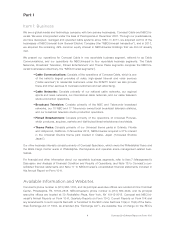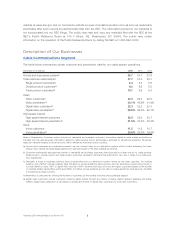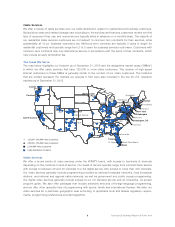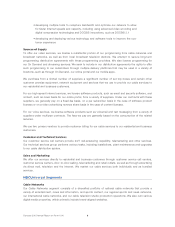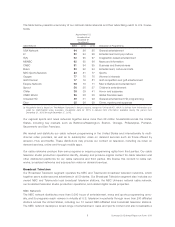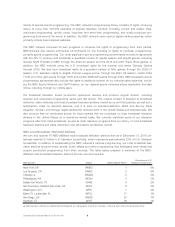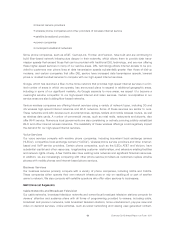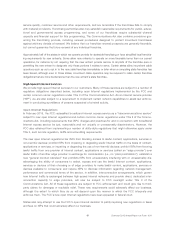Comcast 2015 Annual Report Download - page 14
Download and view the complete annual report
Please find page 14 of the 2015 Comcast annual report below. You can navigate through the pages in the report by either clicking on the pages listed below, or by using the keyword search tool below to find specific information within the annual report.Cable Communications
Competition for our video services consists primarily of direct broadcast satellite (“DBS”) providers, which
have a national footprint and compete in all of our service areas, and phone companies with fiber-based
networks, which overlap more than 55% of our service areas and are continuing to expand the areas they
serve. Our high-speed Internet services business primarily competes with phone companies with fiber-based
networks that overlap more than 60% of our service areas. Many of these competitors offer features, pricing
and packaging for these services, individually and in bundles, comparable to what we offer.
There also continue to be new companies, some with significant financial resources, that offer services that
potentially may compete on a larger scale with some or all of our cable services. In particular, Google, which
has launched high-speed Internet and video services in a limited number of areas in which we operate, has
announced plans to expand in more areas, including in some of our significant markets. As Google expands
to more areas, we expect it to become a meaningful wireline competitor to our high-speed Internet and video
services. Other companies continue to emerge that provide Internet streaming and downloading of video
programming, some of which charge a nominal or no fee. Wireless Internet services, such as 3G and 4G wire-
less broadband services and Wi-Fi networks, may compete with our video and high-speed Internet services,
and our voice services are facing increased competition as customers replace wireline phones with mobile
phones and Internet-based phone services such as Skype.
Video Services
We compete with a number of different sources that provide news, sports, information and entertainment
programming to consumers, including:
• DBS providers that transmit satellite signals containing video programming and other
information to receiving dishes located on the customer’s premises
• phone companies that have built and continue to build fiber-based networks that
provide cable services similar to ours, which now overlap a substantial portion of our
service areas
• other providers that build and operate wireline communications systems in the same
communities that we serve, including those operating as franchised cable operators
• satellite master antenna television (“SMATV”) systems that generally serve MDUs,
office complexes and residential developments
• online video distributors that offer online services and devices that enable Internet
video streaming and downloading of movies, television shows and other video pro-
gramming
Congress has enacted legislation and the FCC has adopted regulatory policies intended to provide a favor-
able operating environment for existing competitors and for potential new competitors to our cable services.
The FCC adopted rules favoring new investment by certain phone companies in networks capable of distribut-
ing video programming and rules allocating and auctioning spectrum for new wireless services that may
compete with our video services. The FCC also has launched a rulemaking to classify certain online video
distributors as multichannel video providers under the FCC’s rules and thereby provide them with certain
regulatory benefits under the rules. See “Legislation and Regulation” below for additional information.
Direct Broadcast Satellite Providers
According to recent government and industry reports, conventional medium-power and high-power satellites
provide video programming to 33.5 million subscribers in the United States. DBS providers with high-power
satellites typically offer video services substantially similar to our video services. DIRECTV, which was
11 Comcast 2015 Annual Report on Form 10-K


